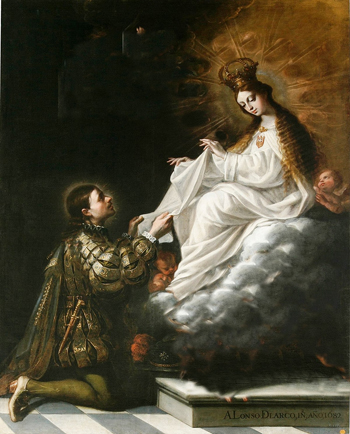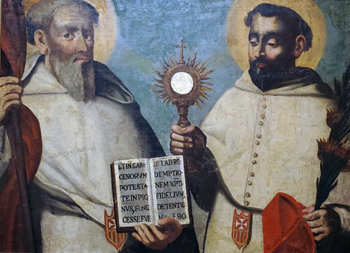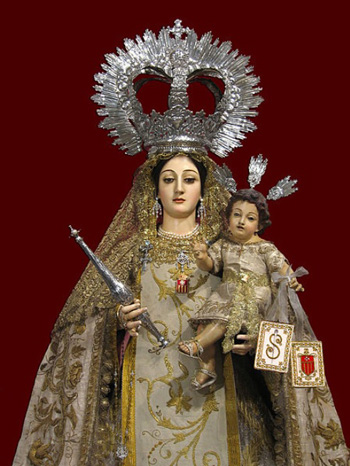Feast Days of Our Lady
 |
 |
 |
 |
 |
 |
 |
Our Lady of Mercy - September 24
Biographical selection:
The Order of the Most Holy Trinity (Trinitarians) and the Order of Mercy were both founded to ransom Christians held captive by Muslims, the latter being founded some 20 years after the first. One difference between the two is that the Mercedarians counted more knights than clerics at its start.
 It called itself the Royal, Celestial and Military Order of Our Lady of the Mercies and the Redemption of the Captives. Its clerics dedicated themselves more particularly to praying the Divine Office in the choirs of the monasteries, while the knights guarded the coasts and were turned toward the dangerous mission of the redemption of Christian prisoners.
It called itself the Royal, Celestial and Military Order of Our Lady of the Mercies and the Redemption of the Captives. Its clerics dedicated themselves more particularly to praying the Divine Office in the choirs of the monasteries, while the knights guarded the coasts and were turned toward the dangerous mission of the redemption of Christian prisoners.
St. Peter Nolasco (1189-1256) was the first General Grand Master of the Order. When his coffin was opened, he was found armed with his armor and sword.
The Church instituted the feast of Our Lady of Mercy to honor the Religious Order founded by St. Peter Nolasco who was asked by Our Lady to dedicate himself to rescuing Catholic captives enslaved by the Moors in Spain. It appears that God had compassion on those unfortunate prisoners who were exposed to the loss of the Faith and innocence and subjected to all possible bad treatments.
On August 1, 1218, St. Peter Nolasco received a vision of Our Lady who told him to found his Order. Dressed in white, she held two bags of coins to be used in ransoming Christians in captivity. She appeared in the same way to St. Raymond of Peñaforte and King James of Aragon with the same request to start a religious order to free Christians from captivity. There was no room for doubt, and it was decided to found the Order, titled Order of Our Lady of Mercy for the Redemption of the Captives.
Comments of Prof. Plinio:
The Order of the Our Lady of Mercy had more knights than priests at its foundation. The priests and religious dedicated themselves to praying the Divine Office; the knights fought. It is a beautiful equilibrium: The main obligation of the religious was to pray, above all for the knights of the Order; the knights fought, taking advantage of the merits earned by the prayers of the religious.
This is an idea that is very dear to me: A Religious Order that would have a purely contemplative branch to pray to make reparation for those who are dedicated to the action and, in so doing, give their action a special fecundity. I have always been a great admirer of this idea.
You may consider this beautiful thing: The first General Superior of this Order was a lay warrior who went to his grave in the armor and sword he used in battle, disposed in this way to appear before the judgment of God. It is a true marvel! It reflects well the ideal of the Catholic warrior.
 I wish we could have the armor and the sword of St. Peter Nolasco in our Chapel! Or, at least, have a replica of them that were touched to the original, so that it would be an indirect relic. Just having this would already be something extraordinary!
I wish we could have the armor and the sword of St. Peter Nolasco in our Chapel! Or, at least, have a replica of them that were touched to the original, so that it would be an indirect relic. Just having this would already be something extraordinary!
You know that the Christians were imprisoned by the Moors and reduced to the condition of slaves. Naturally, they had no religious succor. Can you imagine, the temptation of despair of a Catholic prisoner, immersed in the pagan ambience of immorality and promiscuity of those pagans, who should commit a sin without a priest for confession? "Do I have perfect contrition? Is my attrition sufficient to forgive my sin? Will I have a priest to forgive this sin when I die?" You can imagine all the afflictions and falls that a situation like this can propitiate.
Another horrible thing: Those pagans, abusing their power over the slaves, forced them into all kinds of immoralities. So, the Christians were exposed to the worst things imaginable. Then, under the special direction of Our Lady, Christian compassion looked upon them and inspired the foundation of a Religious Order specially dedicated to the liberation of the captives.
There is always something poetic in the apparitions of Our Lady. She appeared to a King, James of Aragon, to a thinker, St. Raymond of Peñaforte, and to a warrior, St. Peter Nolasco, and asked of all three the same thing. They met and one commented: "Look, I had a vision of Our Lady…" The other two said: "We had the same vision…"
 And so they concluded: "Then, let us found an Order born directly from the smile of Our Lady." It is very beautiful, is it not?
And so they concluded: "Then, let us found an Order born directly from the smile of Our Lady." It is very beautiful, is it not?
The original title of the Order in Spanish refers to Nuestra Señora de las Merceds, a merced is a favor someone does for another, it is a gift someone gives to someone else. The gift that she was promising those prisoners was freedom from their terrible captivity.
The Church lacks invocations enough to inculcate in us the idea of this liberality of Our Lady. She is always disposed to give us excellent graces, to invite us to ask for them, and to love her for the goodness she shows us.
May this invocation open our souls to this type of filial and confidence-filled relationship with Our Lady that those warriors considered essential for their mission.
Although white heresy has a lot of foolish and smiling things to say about devotions, in fact it is not white heresy to trust in the smile of Our Lady and have a special confidence in her smiling mercy.
None of these Saints were white heresy; the least white heresy of them all was St. Peter Nolasco, buried with his armor and sword…

The Saint of the Day features highlights from the lives of saints based on comments made by the late Prof. Plinio Corrêa de Oliveira. Following the example of St. John Bosco who used to make similar talks for the boys of his College, each evening it was Prof. Plinio’s custom to make a short commentary on the lives of the next day’s saint in a meeting for youth in order to encourage them in the practice of virtue and love for the Catholic Church. TIA thought that its readers could profit from these valuable commentaries.
The texts of both the biographical data and the comments come from personal notes taken by Atila S. Guimarães from 1964 to 1995. Given the fact that the source is a personal notebook, it is possible that at times the biographic notes transcribed here will not rigorously follow the original text read by Prof. Plinio. The commentaries have also been adapted and translated for TIA’s site.
The Order of the Most Holy Trinity (Trinitarians) and the Order of Mercy were both founded to ransom Christians held captive by Muslims, the latter being founded some 20 years after the first. One difference between the two is that the Mercedarians counted more knights than clerics at its start.

Our Lady appears to the knight & asks him to found an order to redeem captives
St. Peter Nolasco (1189-1256) was the first General Grand Master of the Order. When his coffin was opened, he was found armed with his armor and sword.
The Church instituted the feast of Our Lady of Mercy to honor the Religious Order founded by St. Peter Nolasco who was asked by Our Lady to dedicate himself to rescuing Catholic captives enslaved by the Moors in Spain. It appears that God had compassion on those unfortunate prisoners who were exposed to the loss of the Faith and innocence and subjected to all possible bad treatments.
On August 1, 1218, St. Peter Nolasco received a vision of Our Lady who told him to found his Order. Dressed in white, she held two bags of coins to be used in ransoming Christians in captivity. She appeared in the same way to St. Raymond of Peñaforte and King James of Aragon with the same request to start a religious order to free Christians from captivity. There was no room for doubt, and it was decided to found the Order, titled Order of Our Lady of Mercy for the Redemption of the Captives.
Comments of Prof. Plinio:
The Order of the Our Lady of Mercy had more knights than priests at its foundation. The priests and religious dedicated themselves to praying the Divine Office; the knights fought. It is a beautiful equilibrium: The main obligation of the religious was to pray, above all for the knights of the Order; the knights fought, taking advantage of the merits earned by the prayers of the religious.
This is an idea that is very dear to me: A Religious Order that would have a purely contemplative branch to pray to make reparation for those who are dedicated to the action and, in so doing, give their action a special fecundity. I have always been a great admirer of this idea.
You may consider this beautiful thing: The first General Superior of this Order was a lay warrior who went to his grave in the armor and sword he used in battle, disposed in this way to appear before the judgment of God. It is a true marvel! It reflects well the ideal of the Catholic warrior.

The two founders: St. Peter Nolasco &
St. Raymond of Penaforte
You know that the Christians were imprisoned by the Moors and reduced to the condition of slaves. Naturally, they had no religious succor. Can you imagine, the temptation of despair of a Catholic prisoner, immersed in the pagan ambience of immorality and promiscuity of those pagans, who should commit a sin without a priest for confession? "Do I have perfect contrition? Is my attrition sufficient to forgive my sin? Will I have a priest to forgive this sin when I die?" You can imagine all the afflictions and falls that a situation like this can propitiate.
Another horrible thing: Those pagans, abusing their power over the slaves, forced them into all kinds of immoralities. So, the Christians were exposed to the worst things imaginable. Then, under the special direction of Our Lady, Christian compassion looked upon them and inspired the foundation of a Religious Order specially dedicated to the liberation of the captives.
There is always something poetic in the apparitions of Our Lady. She appeared to a King, James of Aragon, to a thinker, St. Raymond of Peñaforte, and to a warrior, St. Peter Nolasco, and asked of all three the same thing. They met and one commented: "Look, I had a vision of Our Lady…" The other two said: "We had the same vision…"

Our Lady of Mercies in Cadiz, Spain
The original title of the Order in Spanish refers to Nuestra Señora de las Merceds, a merced is a favor someone does for another, it is a gift someone gives to someone else. The gift that she was promising those prisoners was freedom from their terrible captivity.
The Church lacks invocations enough to inculcate in us the idea of this liberality of Our Lady. She is always disposed to give us excellent graces, to invite us to ask for them, and to love her for the goodness she shows us.
May this invocation open our souls to this type of filial and confidence-filled relationship with Our Lady that those warriors considered essential for their mission.
Although white heresy has a lot of foolish and smiling things to say about devotions, in fact it is not white heresy to trust in the smile of Our Lady and have a special confidence in her smiling mercy.
None of these Saints were white heresy; the least white heresy of them all was St. Peter Nolasco, buried with his armor and sword…
 | |
|
|
The texts of both the biographical data and the comments come from personal notes taken by Atila S. Guimarães from 1964 to 1995. Given the fact that the source is a personal notebook, it is possible that at times the biographic notes transcribed here will not rigorously follow the original text read by Prof. Plinio. The commentaries have also been adapted and translated for TIA’s site.